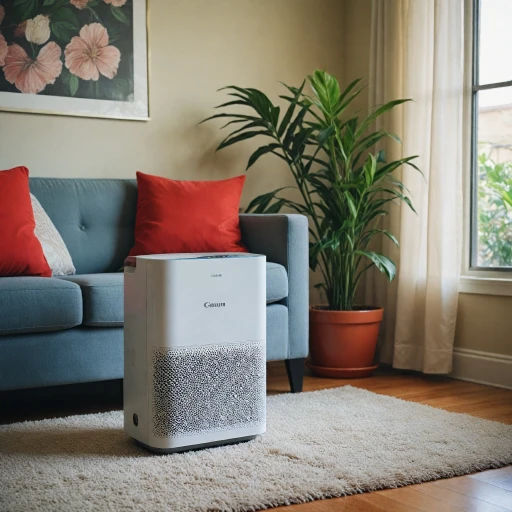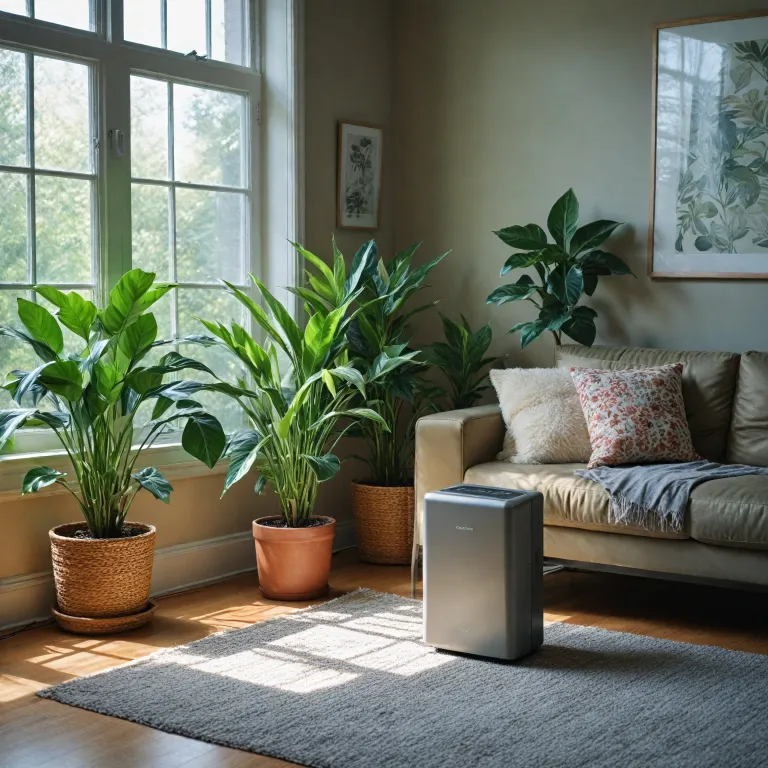Understanding Air Purifiers
Decoding the Functionality of Air Purifiers
Air purifiers are pivotal devices when it comes to maintaining good indoor air quality. They work by filtering out various pollutants and allergens, ensuring that the air you breathe is cleaner and healthier. These devices come in different sizes and functionalities, equipped with multiple types of filters like activated carbon and HEPA filters. By capturing dust mites, mold spores, and odors, air purifiers can significantly improve the air circulation in your home.
Air purifiers don't just filter out particulate matter; their sophisticated technology helps to address specific airborne concerns. This includes the reduction of dust, smoke, and even certain bacteria. It's important to note, however, that while air purifiers excel at reducing pollutants, they do not directly manage the humidity levels in a room. Instead, they focus on maintaining clean air free from unwanted pollutants.
For those dealing with mold, an air purifier can help mitigate some of the associated issues by reducing the mold spores in the air. Understanding these functionalities better can highlight how air purifiers contribute to a healthier living environment. For a deeper dive into air purifiers' role in combating mold, you can
explore more here.
The Role of Humidity in Indoor Air Quality
Impact of Humidity on Indoor Air Quality
Indoor air can often be taken for granted, but the levels of humidity in your home play a crucial role in determining overall air quality. Maintaining balanced humidity levels air is important for both air circulation and comfort. When levels are too low, it results in dry air, which can lead to a host of problems. Conversely, high humidity can bring about different challenges.
Challenges of Low Humidity
Dry air can exacerbate respiratory issues and dry out the skin, throat, and nasal passages. The lack of moisture can further complicate the performance of some
purifiers as well. Rooms with low moisture levels might experience increased static electricity and warping of wooden furniture.
Problems With High Humidity
On the other hand, air environments with high humidity levels can become a breeding ground for mold and dust mites, which are significant allergens. Excessive moisture air also contributes to musty odors that are challenging to eliminate. Mold issues can be particularly concerning, both for air quality and for structural damage to your home.
Optimal Indoor Humidity
The ideal humidity air level for indoor spaces typically falls between 30-50%. Keeping it within this range ensures clean air without promoting mold or causing dryness.
Enhancing indoor air quality can be achieved by considering the right balance and using the appropriate device, whether it's a
purifier with activated carbon filters or a
humidifier to introduce water vapor. Understanding these factors can
help you
shop for devices that suit your needs and improve your indoor air environment.
Air Purifiers vs. Humidifiers: Key Differences
Distinguishing Air Purifiers from Humidifiers
Air purifiers and humidifiers both play unique roles in maintaining indoor air quality, but they serve different purposes. Understand their distinct functions to choose the right device for your needs.
- Air Purifiers: Primarily designed to clean and filter the air in your room, air purifiers work by removing pollutants such as dust mites, mold spores, and odors. These devices use carbon filters and HEPA filters to trap airborne particles, ensuring cleaner air circulation within your indoor environment. Air purifiers don't directly affect humidity levels; their main task is to deliver clean air.
- Humidifiers: In contrast, humidifiers are specifically engineered to manage moisture levels in your home, adding water vapor to the air. This is particularly beneficial in dry air conditions where low humidity can cause discomfort. Unlike purifiers, humidifiers release moisture into the air, effectively increasing indoor humidity levels.
In certain cases, you might want to use both a purifier and a humidifier to maintain a balanced indoor humidity and air quality environment. Some households choose to bundle air purifiers with humidifiers to tackle both pollutants and moisture balance.
For further understanding of how these devices work together to enhance your indoor environment, you can read
this detailed post on the role of a return grille air filter in your home. It provides insights that might help in making an informed decision about which device is suitable for your needs.
Do Air Purifiers Affect Humidity Levels?
The Interplay Between Air Purifiers and Humidity
Air purifiers are well-regarded for their ability to improve air quality by removing pollutants, odors, and allergens. However, many wonder whether these devices can affect humidity levels in a room. Understanding this relationship is key to choosing the right air quality management solutions for your needs.
For starters, air purifiers work by circulating indoor air through various filters designed to capture particles and pollutants. Some models use activated carbon filters to help remove odors and smoke, while others focus on trapping mold spores and dust mites. However, these devices do not add or remove moisture air, which means they do not directly change or control humidity levels.
In contrast, humidifiers and dehumidifiers are specifically designed to manage moisture levels. A humidifier adds water vapor to the air, aiming to alleviate dry air conditions, while a dehumidifier extracts excess moisture to counteract high humidity.
Therefore, while air purifiers can improve indoor air quality by removing impurities, they do not reduce indoor humidity. If moisture air is a concern, you might need a separate device alongside your air purifier. This is particularly true in environments where maintaining balanced humidity levels is crucial to prevent mold growth and ensure comfort.
By understanding how each device operates, you can make an informed choice, whether it is an air purifier, humidifier, or a bundle of both, tailored to your specific indoor air quality concerns.
Choosing the Right Device for Your Needs
Finding the Perfect Air Solution for Your Environment
When evaluating your options for improving indoor air, it's crucial to match the right device to your specific needs. Understanding the distinctions between air purifiers and humidifiers is a great start. But how do you ensure you choose wisely?
- Assess Your Air Quality Needs: Determine if you primarily need to address air quality issues like dust mites, mold, and odors, or if your main concern is managing humidity levels. Air purifiers are excellent for removing allergens and pollutants from the air, thanks to features such as activated carbon filters. However, if your concern is predominantly dry air or maintaining optimal water vapor levels, a humidifier may be the better choice.
- Consider Room Size: Air purifiers come in various capacities. Ensure the device you choose is suitable for the room or space where you intend to use it. This will maximize its effectiveness in improving air circulation and quality.
- Look at Filter Types: For those battling persistent odors or mold, air purifiers with carbon filters are advantageous. These filters are designed to capture gases and mold spores, providing cleaner air. If your environment is experiencing high humidity, consider air purifiers with moisture control features that can slightly influence levels air.
- Shop with Purpose: When browsing devices, consider whether you might benefit from a bundle that includes both a purifier and a humidifier. This can be an efficient solution for homes with variable air and moisture needs.
- Check Versatility: Some purifiers don’t just eliminate dust; they help maintain balanced indoor humidity air, though not all devices affect moisture air levels. It's beneficial to verify the specifications for any humidity-related features if that’s a priority.
By taking a comprehensive look at your indoor environment's needs—ranging from air quality improvements to managing moisture levels—you can make a more informed choice. Whether opting for an air purifier for cleaner, healthier air or a humidifier to counter dry air, using the right device enhances your comfort and wellness significantly.
Tips for Improving Indoor Air Quality
Enhancing Indoor Environment: Practical Steps
Improving indoor air quality requires more than just purchasing an air purifier or humidifier. It's about adopting a comprehensive approach to maintain healthy indoor air.
- Regular Ventilation: Ensure proper air circulation in your home. Open windows and doors when possible to let fresh air in and remove stagnant, polluted air.
- Maintain Humidity Levels: Aim to keep indoor humidity levels between 30% and 50%. This range prevents dry air and hinders the growth of mold and dust mites, contributing to a healthier indoor environment.
- Use Quality Equipment: Invest in air purifiers with efficient filters like HEPA and activated carbon filters. These help trap pollutants, allergens, and odors, ensuring cleaner air.
- Regular Maintenance: Replace air purifier filters and humidifier water regularly. Clogged filters and stagnant water can decrease device efficiency and degrade air quality.
- Control Indoor Pollutants: Minimize indoor pollutants by using natural cleaning products, avoiding smoking indoors, and storing chemicals safely.
- Manage Moisture Sources: Fix water leaks promptly to prevent moisture buildup. This helps in maintaining ideal humidity levels and curbing mold growth.
By implementing these strategies alongside the use of appropriate devices like air purifiers and humidifiers, you enhance the quality of your indoor environment effectively.

